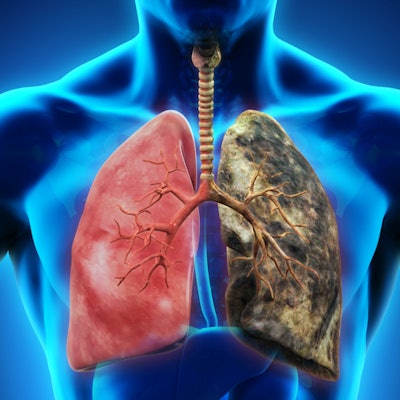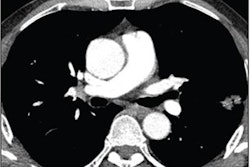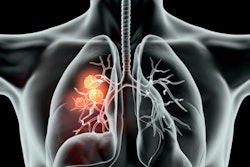
Radiomics features on pretreatment FDG-PET exams can foretell outcomes in patients with non-small cell lung cancer (NSCLC), according to research presented at the 2020 virtual annual meeting of the Society of Nuclear Medicine and Molecular Imaging (SNMMI).
Researchers from the University of New South Wales in Kensington, Australia, found that NSCLC patients with higher levels of a certain radiomic feature were significantly more likely to have poorer survival outcomes than those with lower levels.
"Intratumor heterogeneity quantified by radiomics and analysis of pretreatment FDG/PET can provide independent prognostic information for non-small cell lung cancers treated with curative intent," said presenter Christine Cung.
NSCLC makes up 80% of lung cancers, and is the leading cancer killer worldwide, according to Cung. It has a poor prognosis, with only 25% of patients achieving five-year survival.
"To improve oncological outcomes, novel prognostic biomarkers are sought that may be used in conjunction with [tumor, node, metastasis] stage and genomics to direct aggressive therapy towards patients at high risk of poor survival," Cung said.
Biological intratumor heterogeneity -- the variation of genetic, epigenetic, and phenotypic characteristics within a tumor -- is exhibited to varying degrees by malignant tumors and is predictive of treatment resistance and poor prognosis, Cung said.
"FDG-PET has shown potential to characterize this in vivo on a macroscopic scale by capturing intratumor heterogeneity of FDG uptake and representing this spatial variation in voxel intensities," she said. "Radiomics in oncological imaging involves the extraction and interpretation of quantitative data based on the hypothesis that radiomics features may reflect underlying tumor biology. Given that FDG-PET/CT is routine in staging NSCLC, radiomics analysis of preexisting FDG-PET may improve baseline prognostication."
After a lung cancer multidisciplinary team at the Prince of Wales Hospital retrospectively reviewed 241 patients between 2012 and 2017, they selected 68 patients with histologically confirmed stage I to III NSCLC for the final study cohort. All patients had received pretreatment FDG-PET/CT within 12 weeks of beginning treatment.
Using semiautomated software (Tumour Tracker, IntelliSpace Portal Version 5, Philips Healthcare), two observers in consensus extracted 3D volumes of interest (VOI) with a minimum threshold of 2.5 standardized uptake values (SUV) from primary tumors. These VOIs were then transferred to the open-source 3D Slicer software, which was used to extract 57 first, second, and higher-order textural and shape features.
Cox regression models were utilized to assess the prognostic value of radiomics features against four survival endpoints: overall survival, disease-free survival, local recurrence-free survival, and distant metastasis-free survival. The researchers then determined threshold values for significant radiomics features using receiver operating characteristic analysis. Next, Kaplan-Meier survival curves were constructed to compare survival above and below these thresholds.
Of the 58 patients, 37 had overall survival, 31 were free of local disease, 20 were free of local disease, and 21 were free of distant metastases within a median follow-up period of 25.9 months. The authors found that several radiomics features were significantly associated with survival, most notably kurtosis.
| Survival times for NSCLC patients based on radiomics analysis of PET/CT | ||
| Low kurtosis | High kurtosis | |
| Median disease-free survival | 24 months | 13 months |
| Median local recurrence-free survival | 30 months | 15 months |
| Median distant metastasis-free survival | 30 months | 15 months |
"Patients with higher ketosis had significantly poorer disease-free, local recurrence-free, and distant metastasis-free survival by Kaplan-Meier analysis," she said.





















